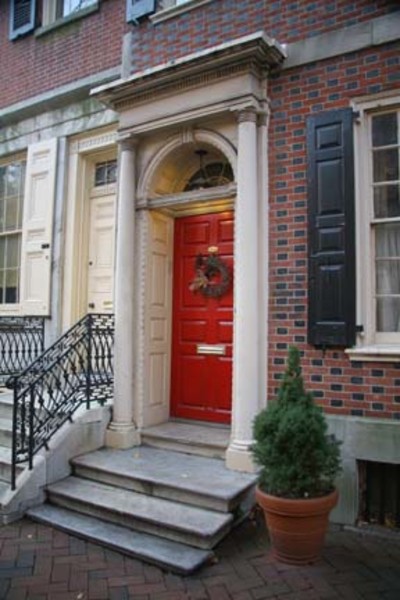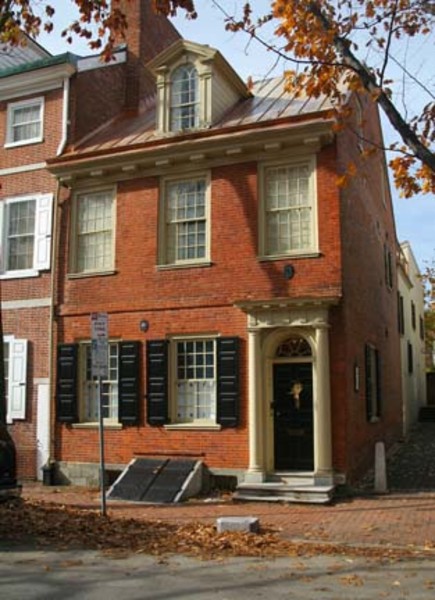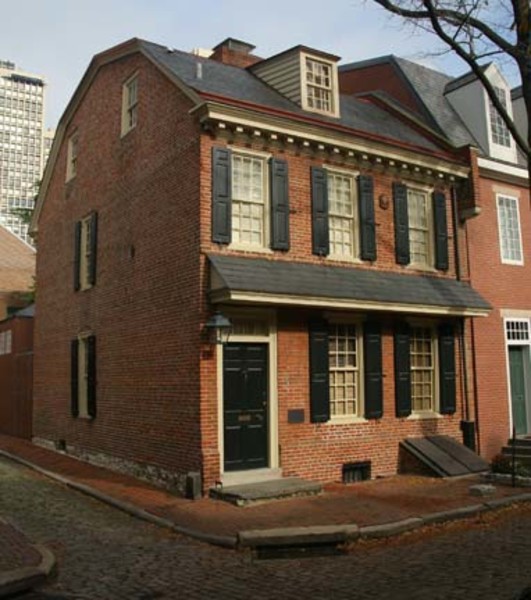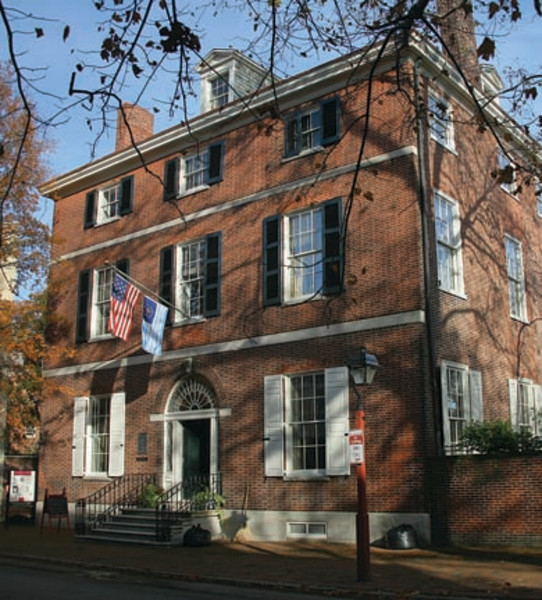
The entrance to the 1790 Pancoast-Lewis-Wharton House is enriched with a Tuscan frontispiece. A King of Prussia marble stoop and Flemish bond brickwork with glazed headers are both typical of the period.
In Philadelphia, the high land between the Delaware River and what is now Eighth Street has a storied past. In the late 1700s, a London development company called the Society of Free Traders sold building lots there, and soon Colonial- and early National-era movers and shakers lined the narrow streets with handsome houses. Thus “The Society’s Hill” came to contain one of the largest concentrations of 18th- and 19th-century houses in America, most of them the brick row houses for which Philadelphia has become famous.
By the 1970s, the neighborhood had become the setting for yet another success story—the renewal of its old buildings’ luster and its cachet as one of the city’s most coveted residential addresses. Today’s Society Hill—a near neighbor to touristy Independence National Historical Park, prestigious mixed-use Washington Square, and Philadelphia’s noisy urban core—is an intriguing architectural blend of sedate antiquity and in-your-face modernity.

Rows of compatible houses build the charm of Society Hill.
Fighting Times
In between these ups, however, were some very conspicuous downs. After the Civil War, Philadelphia’s upper crust moved out, and a myriad of less prestigious tenants moved in, including produce warehouses, slum tenements, saloons, and factories. By the 1960s, Society Hill was deemed “blighted”—fair game for massive redevelopment under Urban Renewal. The proposed revitalization project, intended partly to spruce up the area surrounding nearby Independence National Historical Park and partly to upgrade a notably rundown neighborhood, suggested demolishing hundreds of dilapidated 18th- and 19th-century buildings. These “relics,” including some of the country’s finest Georgian- and Federal-style architecture, were to be replaced by modern high-end residential and commercial new construction.
Historic preservationists, however, begged to differ with that plan. Since the late 1940s, a few dedicated souls had been buying, restoring, and fixing up old Society Hill buildings, risking life and property in the crime-ridden area. Urban Renewal gave them a rallying point and a broader audience, and they sprang into action to save the historic neighborhood. Their efforts helped pave the way for a thoughtful redevelopment-cum-preservation plan put in place by Edmund N. Bacon, Philadelphia’s legendary postwar planning czar.
Though some was indeed lost in the redevelopment, much also remains to be admired in 21st-century Society Hill. In addition to the many cherished antiquities that have been restored or rehabilitated, numerous mid-20th-century infill buildings blend fairly comfortably, if not altogether seamlessly, into the rows of 18th- and early 19th-century buildings.

The house that carpenter Thomas Nevel built for himself in 1770 has a decorated dormer window and an uncommon mutule cornice—good Georgian features.
Construction Clues
Since fire was an ever-present danger in densely built areas, most Philadelphia houses are made of brick. The various brick bonding patterns used in a building’s façade give clues to its date of construction. Decorative Flemish bond, with alternating dark glazed headers (bricks with short ends facing out) and unglazed stretchers (long sides out) with prominent mortar joints, characterize the Georgian style, while the calmer plain Flemish bond (unglazed headers and stretchers) with thinner mortar courses is typical of the Federal style. Common bond later became the norm, as it did everywhere.
Generally, 18th- and early 19th-century houses have gable roofs, although there are a few gambrels. Georgian gables tend to be steeper than Federal ones. As the decades wore on, roofs generally became flatter, and by the 1850s, completely flat roofs had come into use. A few of the earliest houses have pent eaves extending between stories on the front of the house, sheltering the walls and windows below, but these are rare after 1760.
The size and shape of dormers and the size of windows and panes also helps date buildings. Early dormers were plain, usually with shed roofs, but these also appear frequently on small houses of later periods. Georgian dormer roofs are pitched and often pedimented, with elaborately trimmed windows bearing fancy scrolled consoles at the cheeks. In the Federal period, arch-head dormers became fashionable.
Doorways in Georgian houses are often elaborate, with classical frontispieces featuring columns, pediments, and semicircular fanlights, as well as recessed doorways. Simpler houses often have plain doorways, perhaps topped by a transom. Six- and eight-panel doors are standard.

The projecting pent eave between floors and the plain doorway on the 1758 Rhoads-Barclay house are typical of earlier homes.
Georgian Highlights
Largely because of the early Quaker influence in Philadelphia, Society Hill houses tend to be somewhat restrained compared to those in cities like Boston and New York. That said, some of the earliest—and showiest—of the big houses in Society Hill are in the Georgian style. The Powel House on South Third Street, often considered the finest of its era in the city, was built in 1765 for a wealthy merchant, but it’s better known as the home of Samuel Powel, Philadelphia’s first mayor under the new republic. It is known for its elegantly restrained façade and rare side yard. From the outside, lead tracery turns the arched fanlight gracing its front door into a rayed flower of glass beneath a dignified classical entablature. Now a decorative arts museum, the house’s interior contains a dark-mahogany-paneled staircase and handsomely carved mantelpieces with classical motifs.
More subdued is the 1787 Bishop William White House, also a museum house, located on the edge of Society Hill at Third and Walnut streets. The Reverend Dr. White, chaplain of the Continental Congress, chose this handsome brick Georgian-style row house as his residence because it sits midway between the two churches he served. Other houses in the row are all in the Federal style.
Federal Characteristics
Perhaps the easiest way to differentiate between Georgian- and Federal-style houses is to take stock of their visual weightiness. Comparatively speaking, Federal houses usually seem lighter, taller, and less bold than Georgian ones. The Hill-Physick-Keith House (1786) on South Fourth Street offers a low-hipped roof, flat string-courses of stone at the second and third floors, and an impressive entrance with delicate tracery in its arching fanlight and sidelights.
Unlike most Philadelphia houses, which are party-wall row houses, the Hill-Physick-Keith House is a freestanding mansion with a restored side garden. Now a museum, it provides visitors a glimpse of Federal-style furniture in an appropriate setting.

Probably the neighborhood’s finest Federal house, the Hill-Physick-Keith House features a distinctive entry with an elaborate fanlight.
Greek Revival Features
Often called America’s first national style, the Greek Revival is well represented in Society Hill. Girard Row, located in the 300 block of Spruce Street, is a set of five row houses built as an investment in the Greek Revival style in 1833 by Philadelphia financier Stephen Girard. Distinguished by high, marble-faced basements and first stories, with elaborate cast-iron railings beside the marble steps, they remain a handsome intact grouping. The identical Winder Houses on Third Street (1844; architect Thomas U. Walter) have remarkable cast-iron balconies at the second floor, one featuring griffins; the other, lions.
Of course, not all houses of note in Society Hill are mansions or even upper-middle-class residences. There are still plenty of small, working men’s two-story houses mixed in with the three- and four-story dwellings of wealthy merchants and gentry. The 1770 home of master carpenter Thomas Nevel on Fourth Street is a good example—one of many buildings grand and small worth visiting on any tour of Society Hill.







